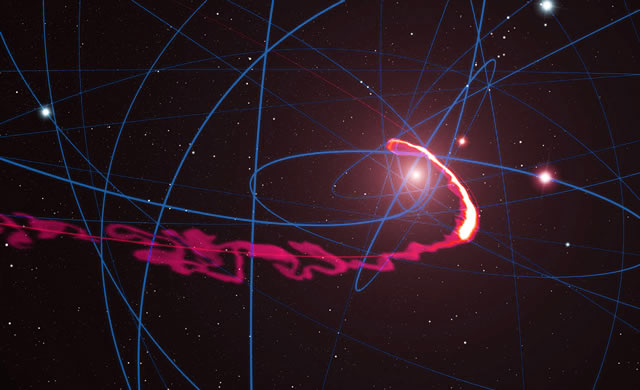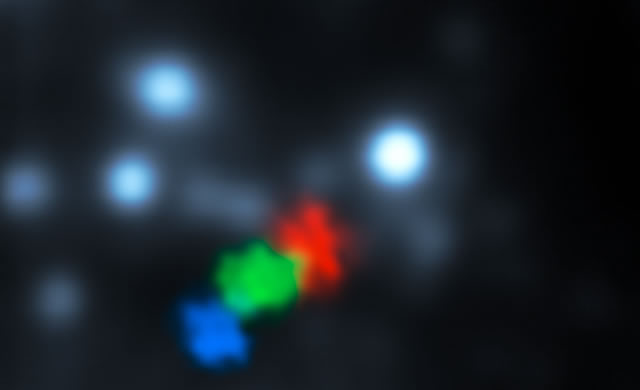
Il VLT osserva in tempo reale una nube di gas mentre si avvicina all’oggetto gigantesco al centro della Via Lattea. Nuove osservazioni del VLT (Very Large Telescope) dell’ESO mostrano per la prima volta una nube di gas fatta a brandelli dal buco nero supermassiccio al centro della Galassia. La nube è così allungata che la parte anteriore ha superato il punto di minima distanza dal buco nero e sta allontanandosi ad una velocità di oltre 10 milioni di chilometri all’ora, mentre la coda sta ancora cadendo verso il buco nero.
Nel 2011 il VLT (Very Large Telescope) dell’ESO ha scoperto una nube di gas di parecchie volte la massa della Terra in accelerazione verso il buco nero al centro della Via Lattea (eso1151). Questa nube sta ora raggiungendo la minima distanza dal buco nero e nuove osservazioni del VLT mostrano che si sta palesemente allungando sotto l’influsso dell’estremo campo gravitazionale del buco nero. “Il gas in testa alla nube si estende ora su più di 160 miliardi di chilometri vicino al punto di minima distanza dell’orbita dal buco nero. E questo punto è solo a poco più di 25 miliardi di chilometri dal buco nero stesso – appena abbastanza per non caderci dentro”, spiega Stefan Gillessen (Max Planck Institute for Extraterrestrial Physics, Garching, Germania) che ha condotto l’equipe osservativa. “La nube è così allungata che raggiungere la minima distanza non si rivela un evento singolo ma piuttosto un processo che dura almeno un anno”. Poichè la nube è allungata la sua luce diventa sempre più difficile da vedere. Ma osservando la regione vicina al buco nero per più di 20 ore in totale con lo strumento SINFONI montato sul VLT – l’esposizione più profonda di questa regione mai ottenuta con uno spettrografo a campo integrale – l’equipe ha potuto misurare le velocità delle diverse parti della nube mentre saetta vicino al buco nero centrale. “Il fatto più entusiamante che vediamo nelle nuove osservazioni è la testa della nube che sta tornando verso di noi a più di 10 milioni di chilometri all’ora lungo l’orbita – circa l’1% della velocità della luce”, aggiunge Reinhard Genzel, a capo del gruppo di ricerca che ha studiato questa regione per quasi vent’anni. “Ciò significa che l’estremità anteriore della nube ha già superato il punto di massimo avvicinamento al buco nero”. L’origine della nube di gas rimane ignota, anche se non mancano le idee a proposito. Le nuove osservazioni aiutano a restringere le possibilità. “Come uno sfortunato astronauta di un film di fantascienza, vediamo che la nube viene stirata così tanto che sembra un fascio di spaghetti. Ciò implica che probabilmente non contiene una stella”, conclude Gillessen. “Al momento pensiamo che il gas provenga dalle stelle che vediamo in orbita intorno al buco nero”.
Fonte/Leggi tutto → ESO.org
VLT watches in real time as gas cloud makes closest approach to the monster at the centre of the Milky Way – New observations from ESO’s Very Large Telescope show for the first time a gas cloud being ripped apart by the supermassive black hole at the centre of the galaxy. The cloud is now so stretched that its front part has passed the closest point and is travelling away from the black hole at more than 10 million km/h, whilst the tail is still falling towards it.
In 2011 ESO’s Very Large Telescope (VLT) discovered a gas cloud with several times the mass of the Earth accelerating towards the black hole at the centre of the Milky Way (eso1151). This cloud is now making its closest approach and new VLT observations show that it is being grossly stretched by the black hole’s extreme gravitational field. “The gas at the head of the cloud is now stretched over more than 160 billion kilometres around the closest point of the orbit to the black hole. And the closest approach is only a bit more than 25 billion kilometres from the black hole itself — barely escaping falling right in,” explains Stefan Gillessen (Max Planck Institute for Extraterrestrial Physics, Garching, Germany) who led the observing team.
“The cloud is so stretched that the close approach is not a single event but rather a process that extends over a period of at least one year.” As the gas cloud is stretched its light gets harder to see. But by staring at the region close to the black hole for more than 20 hours of total exposure time with the SINFONI instrument on the VLT — the deepest exposure of this region ever with an integral field spectrometer — the team was able to measure the velocities of different parts of the cloud as it streaks past the central black hole. “The most exciting thing we now see in the new observations is the head of the cloud coming back towards us at more than 10 million km/h along the orbit — about 1% of the speed of light,” adds Reinhard Genzel, leader of the research group that has been studied this region for nearly twenty years. “This means that the front end of the cloud has already made its closest approach to the black hole.” The origin of the gas cloud remains mysterious, although there is no shortage of ideas. The new observations narrow down the possibilities. “Like an unfortunate astronaut in a science fiction film, we see that the cloud is now being stretched so much that it resembles spaghetti. This means that it probably doesn’t have a star in it,” concludes Gillessen. “At the moment we think that the gas probably came from the stars we see orbiting the black hole.”

Source/Continue reading → ESO.org





















